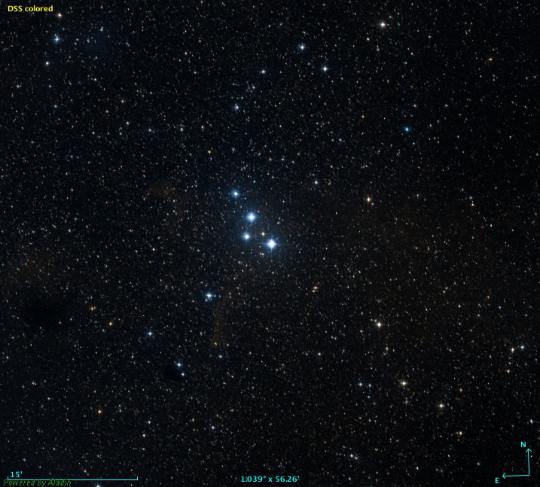September 2016 - Double Star of the Month
Located in Cepheus, STT 461 = 15 Cephei (22 03 53.86 +59 48 52.5) offers a stellar grouping which more resembles an asterism than a multiple star. On the basis that a picture is worth a thousand words, an image from the POSS Quick V survey is appended showing the main components of the group.

STT 461 is located close to the galactic equator and can be found about 2 degrees north-west of the orange supergiant zeta Cep. (mag. 3.4), the most south-easterly of the five bright stars in the pentangle of Cepheus. W. J. Hussey, who re-observed the complete STT catalogue using the Lick 36-in (1901) merely measured AB and the 9th magnitude companion C. The WDS lists eight stars to mag 14.3; the primary star is a hot B1 dwarf of magnitude 6.6 and has B (mag 11.4) 11" distant in PA 297. C which is a K0 giant is 90" away in PA 40. There is little relative motion in the group, which, if the stars are all at the same distance as A, lies about 1500 light years away.
One of S. W. Burnham's earlier discoveries (BU 172), made with the 6-inch Alvan Clark refractor, was 51 Aquarii (22 24 06.87 -04 50 13.2). At that time Burnham's telescope was not fitted with a micrometer so his friend and colleague, Baron Ercole Dembowski in Italy measured the pair for him. In 1875 the two stars were at PA 20 degrees and separated by 0".46 so offered a tough test for Dembowski's 7.5-inch refractor.
The pair then slowly closed through most of the last century, reaching a minimum distance of 0".11 around 1987 when the position angle was changing by 20 degs per year. A good set of speckle measures since then means that the orbit is now tolerably well-known. The period is 145 years and at the time of writing the separation was just under 0".5 and widening, with the companion almost at the point in the orbit where it was discovered last time around.
A good 20-cm should show the pair but its fairly low altitude means the air needs to be steady. On 1782 Oct 2, William Herschel noted three faint and distant companions to 51 Aqr, but the duplicity of the primary star, then close to its maximum separation of 0".6, escaped him.
Bob Argyle - Double Star Section Director